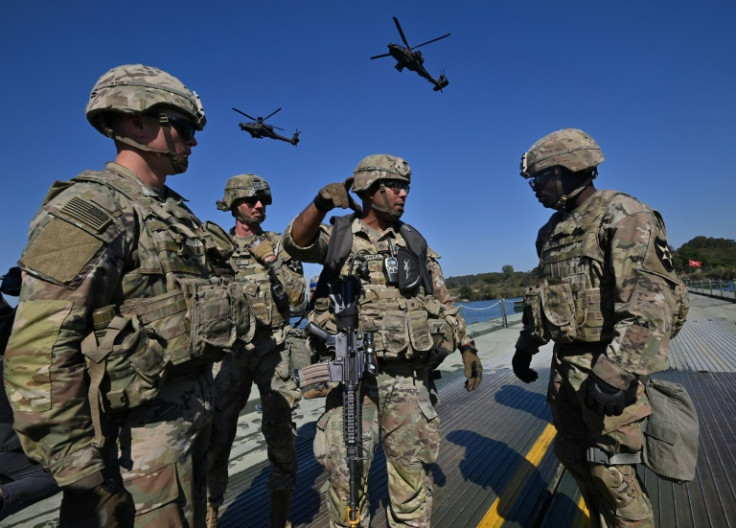World War 3 Could Be High-Tech: These 7 Technologies Are Keys To Victory

KEY POINTS
- A CSIS report urged the U.S. military to have vision and humility to upgrade its capabilities
- The report used two conflict scenarios to identify technologies that could help the U.S.
- Bioengineering, artificial intelligence and robotics are crucial to winning a war
A global security think tank has released a report identifying seven technologies vital for the U.S. and its allies to win conflicts, including World War III.
Dubbed "Seven Critical Technologies for Winning the Next War," the report by the Center for Strategic and International Studies (CSIS) dives into experts' discussion of the likely trajectory of the future of war and which technologies are crucial for victory for the U.S. and its allies.
"In order to maintain a deterrent, the U.S. national security apparatus needs vision and humility—vision to see the capabilities needed to prevail in competition and humility to let industry partners provide solutions off the shelf that achieve most of the U.S. government's needs," the CSIS said.
The report identified two main scenarios where the seven technologies could be used.
The first scenario is "smolder" or conflicts short of a full-blown war where countries use all state power elements.
The other scenario is called "hot blast," where the U.S. would need a "highly mobile and expeditionary military" and other modes of technology to win the war.
The CSIS grouped the seven technologies into two: sprint technologies, which the U.S. should develop with urgency, and the other one is "follow" technologies, which the U.S. could tap into and influence the private sector's efforts.
Under the "sprint" technologies are secure and redundant communications, bioengineering and quantum technology.
Meanwhile, space-based technology, high-performance batteries, artificial intelligence and robotics belong to "follow" technologies.
1. Secure and Redundant Communications
The study delved into the importance of secure and redundant communications between military units.
"Redundancy will be a combination of satellite and ground-based capabilities, and truly effective communications systems will be secure and seamless across services," according to the report.
The CSIS also highlighted the role of high-end sensor suites and real-time targeting data in ensuring effective communications between troops.
The think tank cited Ukraine's experience in its war against Russia when it hunted Russian troops using communication signatures.
The report also mentioned Beijing's move to target the U.S. communication networks to extract classified military information, urging officials to avoid products owned or manufactured by foreign companies which could be compromised.
2. Quantum Technology
The report called on the U.S. to invest in quantum technologies, as it would "revolutionize computing power, encryption, and sensing."
The think tank said quantum computers would allow the military to "measure subtle changes in an environment, including rotation, electromagnetic signals of any frequency, and temperature."
The CSIS added that quantum computing would allow the U.S. to scoop information on countries that failed to update their encryption practices.
3. Bioengineering
The study emphasized bioengineering's potential to transform weapons production.
The CSIS claimed that bioengineering could be applied to creating explosives, plasticizers and binders. It may also be used to create more effective protective gear for soldiers.
Editing bacterial genomes to create medicines and fuel using the technology could also help alleviate pressures in the supply chain, especially for dispersed forces.
This technology could also pivot to inventing bioweapons and tracking individuals using programmable vaccines.
4. Space-Based Technology
The CSIS suggested tapping space-based technology to "create a definitive edge in the space domain."
The report said on-orbit satellites equipped with hyperspectral and increasingly sensitive sensors and AI/ML algorithms could help provide clearer data quickly.
It cited the National Reconnaissance Office's investment in hyperspectral imagery from space and the planned launch of its first satellite this year.
Researchers also noted the private sector's entry into space by launching communication satellites, which aims to provide fast and affordable internet connectivity and process earth observation data.
However, governments' heavy reliance on private communication companies could spark a national security issue. For example, Ukraine heavily relied on Elon Musk's SpaceX during the Russian-led war for satellite internet services.
5. High-Performance Batteries
The study noted that the future's long-lasting, light and reusable types of batteries could provide a critical edge in the war.
Next-generation and rechargeable batteries could power a soldier's communication devices, attack drones and long-dwell undersea vehicles.
Other batteries could also help power miniaturized satellites and microbots crucial for surveillance and communications.
6. AI/ML
Artificial Intelligence (AI) and Machine Learning (ML) also offer a wide array of tools to help combat forces on the battlefield.
The study noted that robots with AI/ML could autonomously perform more complex tasks, possibly reasoning their way through a battlefield or identifying targets.
AI/ML could also be used for decision-making, for example, in identifying the best path for penetrating defenses without waiting for a human response.
The technology could also be linked with bioengineering to create viable products and build new compounds from thousands of combinations of molecules.
7. Robotics
Robotics lessen the need to deploy troops on the ground and the risks to their lives.
Robots could be used to secure perimeters, dispose of improvised explosive devices (IEDs) and conduct reconnaissance missions.
Military robots could also provide logistical support, including carrying heavy equipment, retrieving and extracting wounded soldiers, clearing mines, and conducting damage assessments.
The CSIS cited Israel Defense Forces' Jaguar, a six-wheeled, semi-autonomous unmanned ground vehicle (UGV) equipped with a 7.622 mm MAG machine gun and self-destructed mode if it fails into enemy hands.

© Copyright IBTimes 2025. All rights reserved.





















